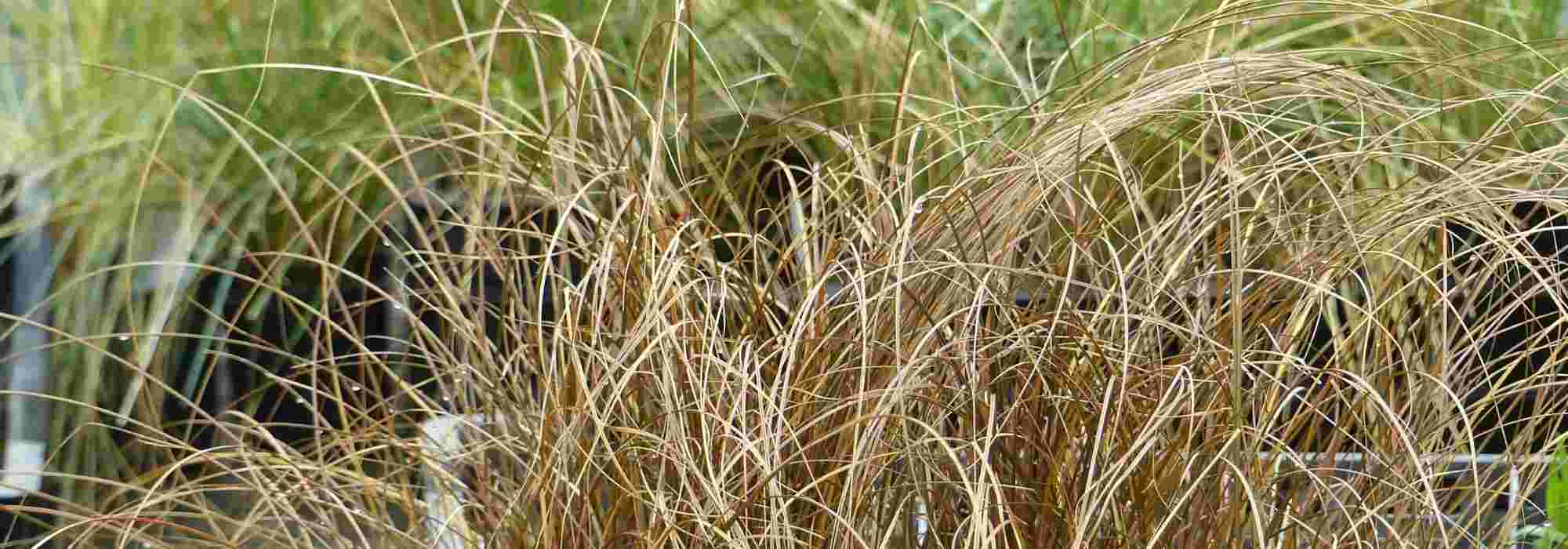
Carex: buyer's guide
Everything you need to know to make the right choice
Contents
Driven by a growing appetite for natural planting, grasses have become a staple in our urban spaces and gardens in recent years. Carex (or sedges), a familiar name, are often less well known than grasses. Often lumped with them but in fact belonging to the family Cyperaceae, these medium-sized perennials with fine foliage are a smart choice if you have a relatively cool site. Bringing great movement and light to flower beds, they create subtle, airy atmospheres all year round.
Among roughly one hundred varieties found in France, there is sure to be a Carex suited to your garden or terrace setting! Follow our buying guide to find the plant that will surely thrive in your garden or on your balcony.
Depending on soil type
In their native habitats, wetlands in cool temperate climates, Carex mainly grow in cool, even marshy soils. Some can, however, thrive in drier ground. Here’s a quick guide :
In moist soil
This is prime habitat for Carex! Some with green foliage even tolerate occasional flooding, which sometimes allows their use as marginal or pond plants.
Carex sylvatica, with a very wild habit, likes moist, cool soils, and even copes with clay! Much like Carex morrowii, very elegant with its variegated evergreen leaves. Finally, Carex pendula is also comfortable in moist, even waterlogged soil.
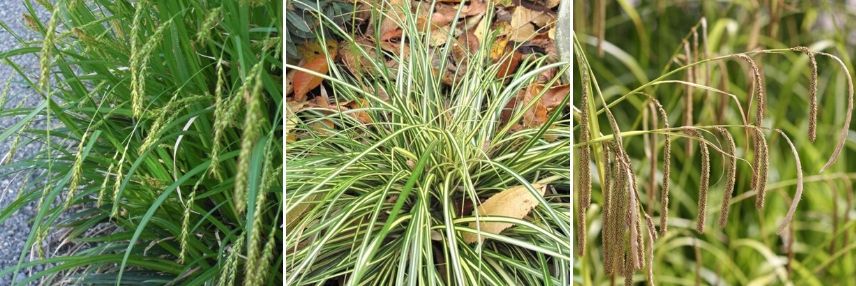
Carex sylvatica, Carex morrowii ‘Variegata’ and Carex pendula
In dry soil
This suits many Carex species native to New Zealand. Still, ensure watering during prolonged dry spells.
Carex testacea, orange-brown and about 50 cm tall, will thrive in dry soil, where it will display the languid curves of its long, very fine leaves!
Carex grayi grows in dry to fresh, rather acidic, rich, humus-bearing soil, in partial shade. Its light-green foliage is broad and bright. In summer it produces very distinctive small, club-shaped inflorescences. Ideal for a pond edge or a shady mixed-border. Pair with some Liriope, hostas or ferns.
Note that Oshima sedge (Carex oshimensis) adapts remarkably well to dry shade.
Read also
Carex: planting, dividing and careDepending on its hardiness
Sedges are native to Europe, North America and New Zealand. Most are very hardy, particularly those with green, golden and variegated foliage, making them suitable for many gardens across France without fear of frost. Often hardy to −10°C, even to −25°C for some varieties, (Carex morrowii ‘Ice Dance’ is perfectly hardy to −22°C), some however may suffer in a pot below these sub-zero temperatures. They should therefore be chosen carefully for that specific situation.
A number of Carex, identifiable by their orange to brown colouring, originate from New Zealand and are a little less hardy (on average to −7°C). I strongly recommend planting them in well-drained soil to avoid exposing them to excessive moisture that would be detrimental during winter months. Furthermore, this will increase their hardiness to −15°C under optimal sun exposure. I am thinking in particular of Carex buchananii for example.
Discover other Carex
View all →Available in 2 sizes
Available in 1 sizes
Available in 0 sizes
Available in 3 sizes
Available in 3 sizes
Available in 2 sizes
Available in 3 sizes
Available in 1 sizes
Available in 2 sizes
Available in 3 sizes
Depending on the colour of the foliage
Light foliage of sedges is highly sought after and their inflorescences remain very discreet. They offer a rich palette of colours that allows a multitude of combinations, with other perennials, bulbs or other Carex, even taller grasses!
Two main colour groups of foliage can be distinguished: Carex with green leaves, including all green variegated forms, and Carex with orange, bronze, copper to brown foliage.
Within both groups, a wide palette of shades is available, up to blue among the greens, and red among the browns. As mentioned earlier, the wide range of brown–orange hues often originates in New Zealand, which explains lower frost tolerance, whereas green Carex will, overall, be hardy down to -20°C.
The subtle colour variation through the seasons is another of their assets: the Carex ‘Prairie Fire’ colours at the leaf tips. They are olive green then take on a beautiful orange hue as the season progresses, bringing remarkable brilliance to a border in autumn! The Carex dispacea (or autumn sedge) also turns from green to copper with first frosts.
-
The « greens »
The Carex muskingumensis (height 60 to 80 cm), deep green and very striking, is particularly original in the shaping of its foliage.
-
The « variegated »
Carex oshimensis ‘Evergold’ forms a very dense clump about 30 cm high in all seasons, bringing plenty of brightness with its long cream bands.
A Carex morrowii ‘Ice Dance’ is perfect as a groundcover to brighten a slightly shady spot, with variegated foliage marginate with cream.
⇒ Discover our selection: 6 Carex with variegated foliage.
-
The « blues »
Choose without hesitation Carex flacca ‘Blue Zinger’, a sedge of velvety blue that full sun exposure intensifies, to obtain a perennial groundcover under tree canopy or in a saline medium. It is one of the rare blue foliages to perform perfectly in shaded areas! The attractive Carex ‘Bunny blue’ is another option to carpet a dry, sunny spot or a place in part shade.
-
The « orangey »
The Carex testacea is a superb semi-evergreen sedge of a beautiful coppery-orange red 40 to 60 cm high. Ornamental with orangey highlights and olive green, it will look superb accompanied by smaller Carex in various tones to accentuate its lovely reflections. Adopt this grass without hesitation if you have dry soil. Indeed, it tolerates drought very well.
Carex buchananii (Buchanan’s sedge) has evergreen foliage. Unusual, it retains its superb reddish-brown colour all year. With an average height of 40 to 60 cm, it will be showcased in borders, equally comfortable in sun or part shade, in well-drained soil.
Close to Buchanan’s sedge, Carex comans ‘Bronze’ is notable for its long, pinkish-brown foliage that undulates very prettily in borders.
→ Read also: 7 grasses with bronze foliage
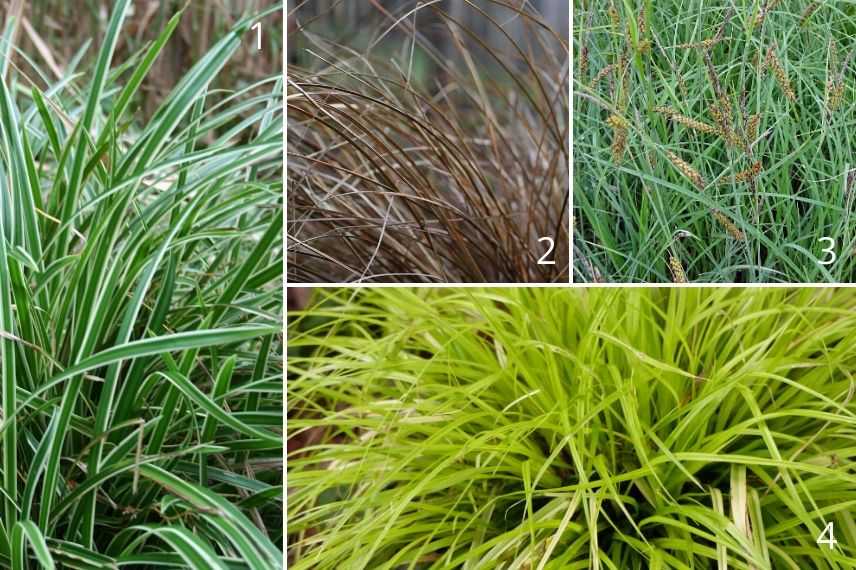
Several foliage colours: 1. Carex morrowii ‘Variegata’ / 2. Carex buchananii / 3. Carex flacca ‘Blue Zinger’ / 4. Carex oshimensis ‘Everillo’
Depending on exposure
8 Carex for shade
According to growth habit
Carex are mostly cespitose plants, meaning they grow and expand to form dense, compact tufts, without ever becoming invasive. To obtain greater coverage, especially for low sedges grown as groundcover, they should be propagated by division of stumps.
But some varieties are suckering (running), meaning they will colonise space via stolons. These are underground stems that root and thus multiply the plant. This is very useful when wanting to increase, without intervention, an area being established in a garden (or a large planter)! This is the case with Carex flacca ‘Blue Zinger’.
Some sedges, less numerous, spread by natural dissemination of their seeds: they therefore have the ability to self-seed. This is useful within a large natural garden or in meadow scenes; in that case choose Carex pendula, with very flexible habit. Reaching 1.50 m in height, it will quickly colonise and harmonise large open spaces. Carex buchananii self-seeds naturally, without excess. It is therefore ideal for composing and enlivening natural areas with its erect habit.
Conversely, if you wish to contain a clump of Carex to a specific area, choose among sedges that remain politely in place, thickening gradually; there are many. I particularly like Oshimensis ‘Everillo’ sedge which is perfect in this situation. It grows to 30 cm in height; its chartreuse foliage (yellow-green) is ultra-bright. Over time it will form a charming groundcover in shaded beds or will adorn a border.
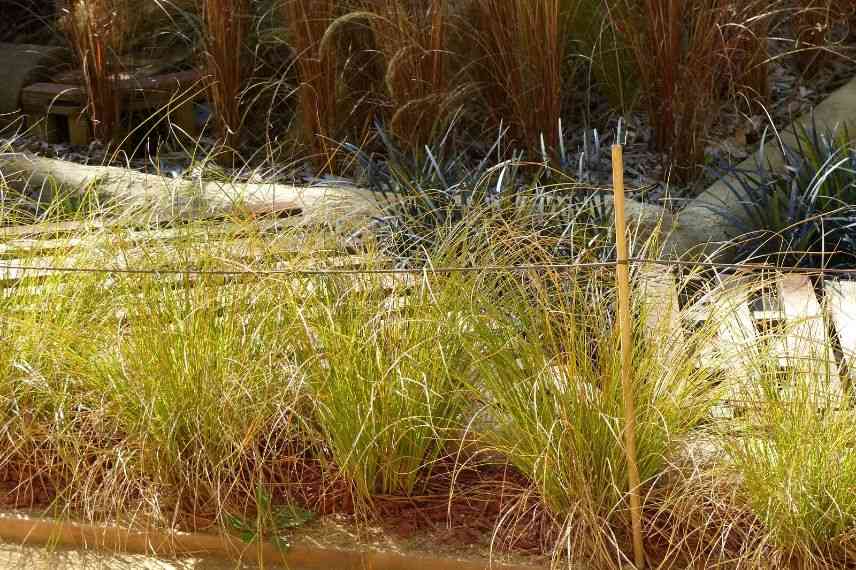
Border of Carex testacea, cespitose, non-invasive species
Carex suitable for growing in pots
One great advantage of Carex is they easily acclimatise to being grown in pots or window boxes, on a terrace, a balcony or a small urban garden. Sedges often remain compact and are perfectly suited to this context. Take care, however, that exposure should not be subject to excessive heat. Carex are evergreen grasses to keep display all year round!
Place taller sedges on high pots, in hanging baskets or on a pedestal to benefit from the beautiful effect of their trailing foliage, as with a Carex oshimensis ‘Feather Falls’. It has long variegated leaves with cream and tolerates both sun and cold, bringing a very bright touch to a terrace.
You can also combine several smaller sedges in a larger pot to create an elegant cushion of foliage. Among varieties particularly elegant in pots, Carex morrowii ‘Ice Dance’ brings a bright, very graphic touch. It is especially well suited to patios or contemporary courtyards.
Carex with green leaves are those that tolerate moisture best. Install a water-retaining saucer under your pots to keep required freshness for as long as possible. Carex oshimensis ‘Evergold’ is ideal for creating a lovely composition, provided it is not placed in overly hot exposure or exposed to excessive cold in winter.
Larger Carex can be grouped in a deeper, well-drained planter to compose a magical ensemble. The upright clumps of Carex muskingumensis will adapt perfectly to an exotic-inspired patio: its leaves resemble a mini palm! Best positioned in part shade, it is also very hardy (‑20°C).
When a plant becomes too cramped, which can happen from the second year after planting, repotting or division at the end of winter is necessary.
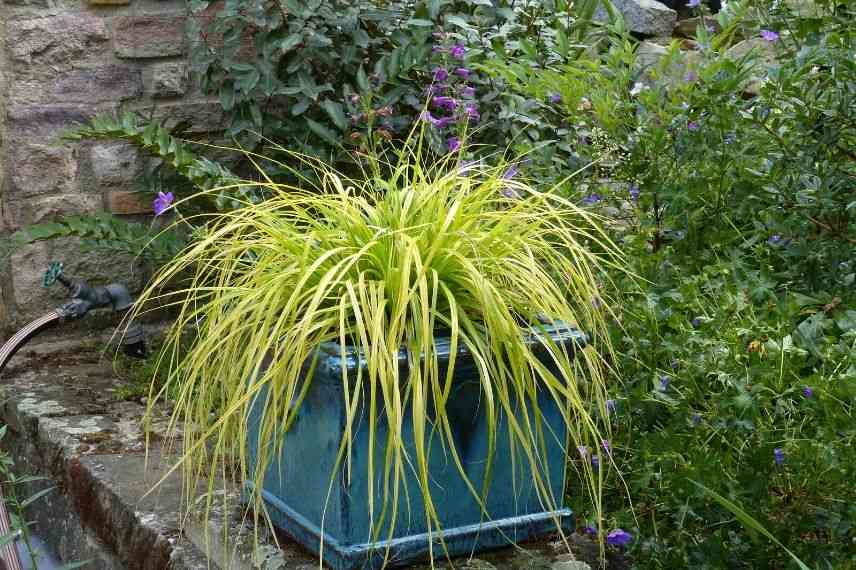
Carex ‘Everillo’ grown in a pot
- Learn more in our advice sheetTo grow and care for Carex in pots
Find out more
Discover everything you need to know about this beautiful ornamental grass: Carex — planting, dividing and care and visit our online nursery to choose species and varieties of Carex perfect for your garden!
- Subscribe!
- Contents
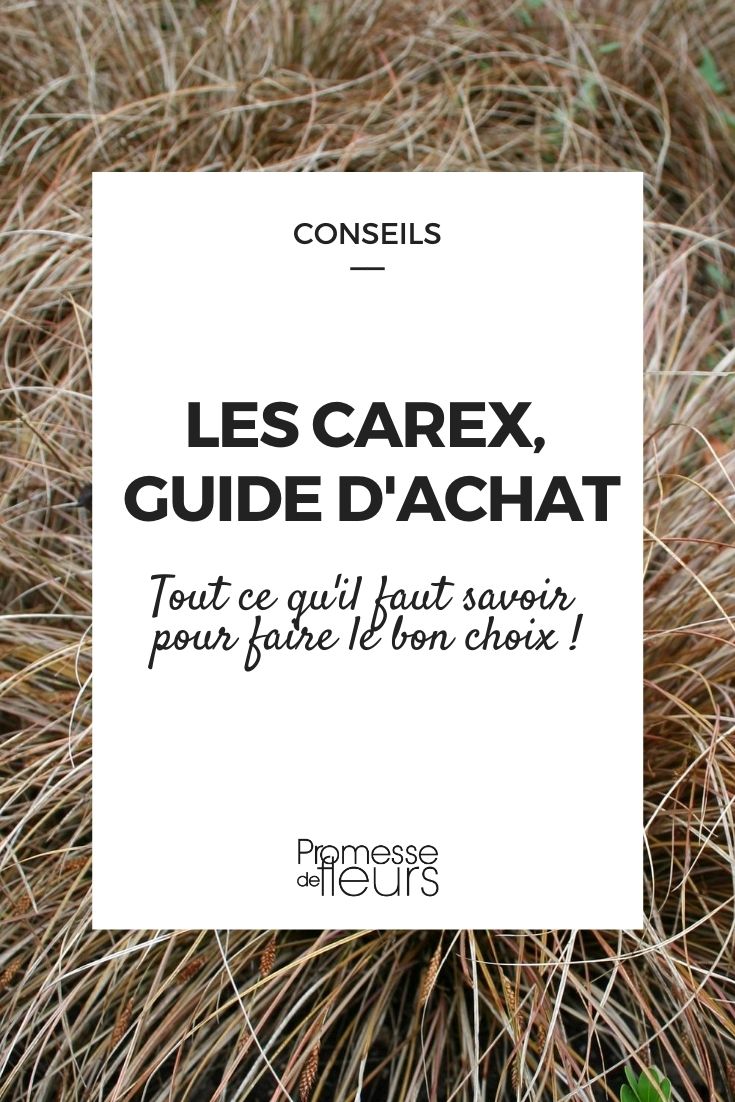































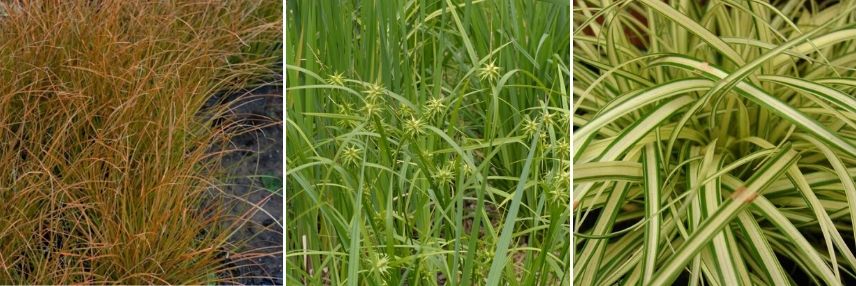
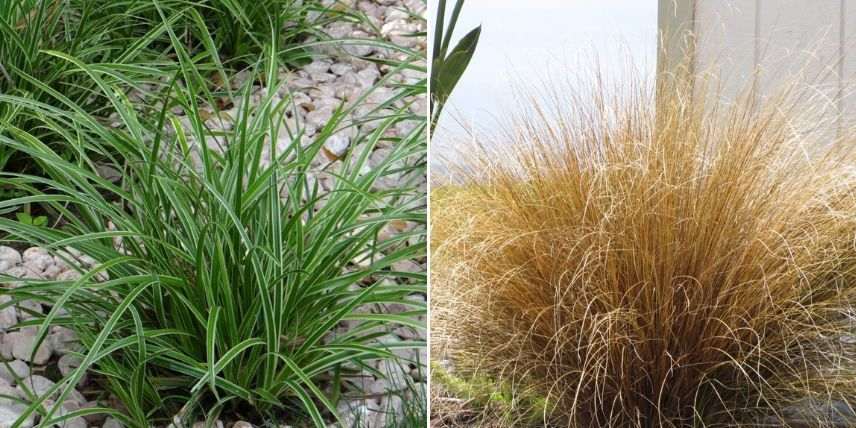
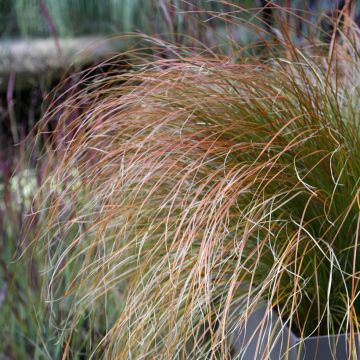
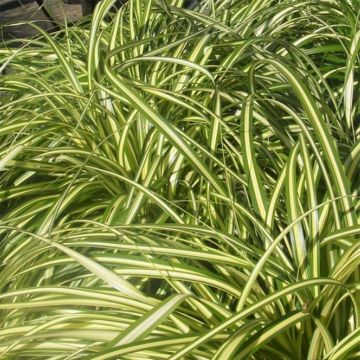

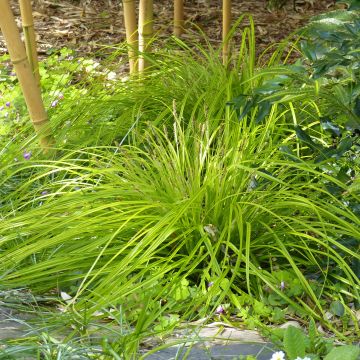
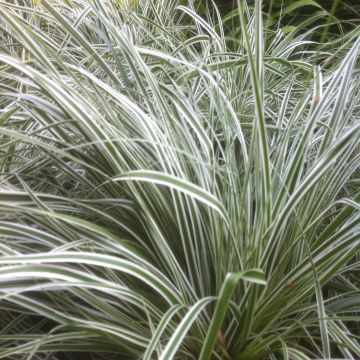
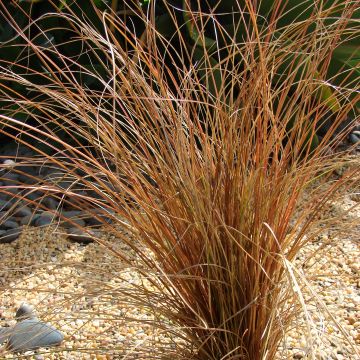
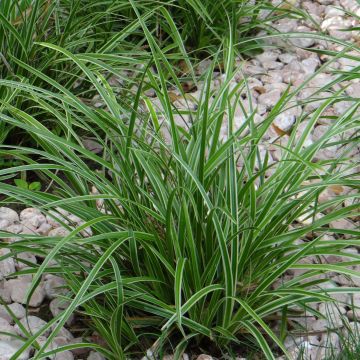
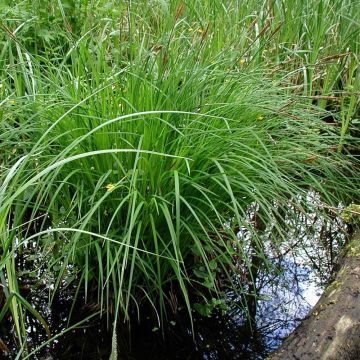
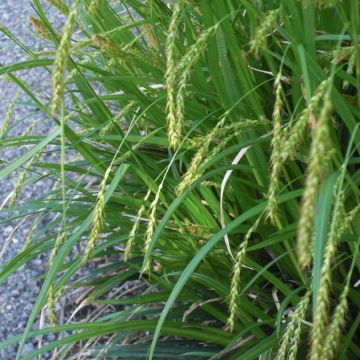
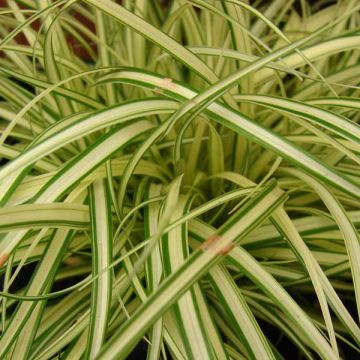
Comments